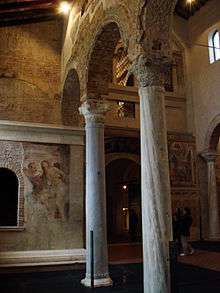Ansa, Queen of the Lombards
Ansa or Ansia[1] (died after 774)[2] belonged to an aristocratic family of Brescia and was the wife of Desiderius (756-774), King of the Lombards. The Latin name does not imply a Romano-Italic origin, as Romans and Lombards in the eighth century tended to take either German or Latin names. She was probably a Lombard, the daughter of Verissimo and sister of King Hildeprand, Arechis, and Donnolo, and niece of King Liutprand.

In or around 753, she founded the monastery of S. Michele and S. Pietro at Brescia.[3] Her husband meanwhile, had become a royal officer and the couple moved first to the royal court, and then to Tuscany, when Desiderius became 'Duke of Tuscia'. After the death of King Aistulf, Desiderius managed to take the throne and Ansa become queen, actively collaborating with her husband, especially in religious matters. In Brescia, she expanded the previously founded monastery, which became the monastery of San Salvatore, endowed it with exceptional wealth and made her daughter Anselperga the abbess. The jurisdiction of San Salvatore subjugated an entire network of monasteries in Lombardy, Emilia and Tuscany, creating a federation directly controlled by the sovereign.[4]
After 759, she appeared frequently in Desiderius' diplomas and was probably the architect of his religious policy.[5]
On 5 June 774, she was presented along with her husband to Charlemagne, who had conquered Pavia. Paul the Deacon wrote an Epitaphium Ansae reginae praising her politics, her piety, and her beauty: coniunx pulcherrima, "most beautiful wife"[6] was certainly active in the political and presumably contributed to the marriage policy that made the Lombard monarchy a major European power.
Her children with Desiderius were a son and four daughters:
- Anselperga (or Anselberga), abbess of San Salvatore
- Adelperga (or Adelberga), married Arechis II of Benevento
- Liutperga (also Liutpirc or Liutberga), married Tassilo III of Bavaria
- Desiderata or Ermengarda, married Charlemagne in 768, divorced in 771
- Adelchis (or Adalgis), patrician in Constantinople[7]
After the fall of the Lombard kingdom by Charlemagne Ansa was locked up with her husband and daughter without a name, maybe Desiderata, at a monastery of the Carolingian Empire, in Liège or Corbie. A local tradition, however, that it was buried in the monastery founded by her, so it is possible that, after the death of her husband, Ansa, now elderly, received permission to retire to Italy.[8]
Alessandro Manzoni wrote the tragedy Adelchi about her son in 1822.
References
- ↑ "Ansa, Queen of the Lombards". tutorgigpedia.com.
- ↑ "Regina dei longobardi". treccani.it.
- ↑ G.Bognetti, La Brescia dei Goti e dei Longobardi, in Storia di Brescia, I, Brescia 1963, p. 435,
- ↑ Jörg Jarnut, Storia dei Longobardi, p. 120.
- ↑ C. Helbling, Ansa, in Dizionario Biografico degli Italiani, vol. £, Rome 1961, p. 361.
- ↑ Jarnut, p. 126; Sergio Rovagnati, I Longobardi, p. 92.
- ↑ Dizionario Biografico degli Italiani Volume 3. 1961.
- ↑ A. Magnani, Le regine longobarde a Pavia, p. 91,"Studi sull'Oriente cristiano", 16/2012.
Bibliography
- Jörg Jarnut. Einaudi,2002 Turin, ed. Storia dei Longobardi. ISBN 8846440854.
- Sergio Rovagnati. Xenia,2003 Milan, ed. I Longobardi. ISBN 8872734843.
- Pier Maria Giusteschi Cinti. 2009 Bologna, ed. Le regine nell’alto medioevo.
- Paolo Diacono. Historia Langobardorum.
Sources
- Ghisalberti, Alberto M. Dizionario Biografico degli Italiani: III Ammirato – Arcoleo. Rome, 1961.